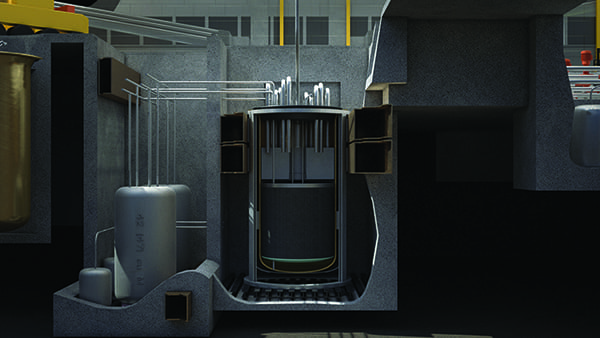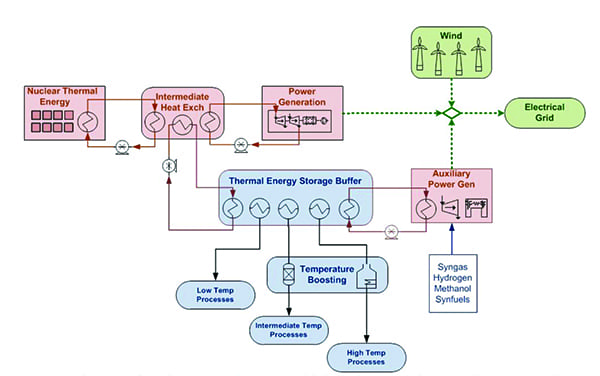How Nuclear Hybrids Could Redefine the Industry’s Future
Credit to Author: POWER| Date: Thu, 01 Aug 2019 00:00:00 +0000
The world’s nuclear sector is struggling to stay economically afloat amid a deluge of renewables and natural gas power, and reinvigorating it will require operational flexibility from new or existing reactors, or force nuclear operators to find new ways to earn revenue. But as research from several entities suggests, the sector may be able to achieve both if it joins forces with other power sources and finds new use cases. This “nuclear hybrid” concept has garnered attention and investment dollars from several entities worldwide, who are optimistic a commercial offering will be available relatively soon.
Among them is the U.S. Department of Energy’s (DOE’s) Office of Nuclear Energy. Through a dedicated program to expand the role of nuclear energy beyond just supplying power to the grid, the agency says it is developing integrated energy systems that include “multiple energy inputs.” These include nuclear, renewables, and fossil fuels, as well as energy users (such as grid energy consumers, industrial heat or electricity users, and transportation fuel users), and mass energy storage.
A Tight Concept
The Idaho National Laboratory (INL), which is spearheading the DOE’s efforts, provides a tighter definition of the term “hybrid systems”: It is a “concept that is capable of providing energy—thermal or electrical—by integrating two or more energy resources to generate two or more products, one of which must be an energy commodity, such as electricity or transportation fuel.” INL adds, “This definition requires coupling of subsystems ‘behind’ the electrical transmission bus, where energy flows are dynamically apportioned as necessary to meet demand, and the system has a single connection to the grid that provides dispatchable electricity as required while capital-intensive generation assets operate at full capacity.”
 |
1. A two-year-long project will examine how efficiently and economically Terrestrial’s Integral Molten Salt Reactor (IMSR) power plant can produce industrial-scale hydrogen. It will test a hybrid sulfur process, which is a carbon-free method of generating hydrogen from water and “may be more efficient than high-temperature steam electrolysis,” Terrestrial said. Courtesy: Terrestrial Energy USA |
As some experts note, reactors currently in the design phase may be able to most easily adopt new operational paradigms that include the use of both thermal and electrical energy from baseload fission generation systems. Last September, for example, Terrestrial Energy USA joined forces with Southern Co. and several DOE national labs in a two-year research and development (R&D) project that will examine how efficiently and economically Terrestrial’s Integral Molten Salt Reactor power plant (Figure 1) can produce industrial-scale hydrogen. The project will use a hybrid sulfur thermochemical process for splitting water to produce hydrogen and oxygen that DOE’s Savannah River National Laboratory (SRNL) has been developing for decades.
However, discussions among members of a utility advisory committee founded in May 2017 to provide advice to the DOE’s Nuclear-Renewable Hybrid Energy Systems (N-R HES) program, and research from the labs themselves, suggest there may be many opportunities to repurpose the current fleet of reactors as hybrid systems. INL notes the N-R HES concept was first presented to an Electric Power Research Institute technical advisory group tasked with exploring flexible operations at nuclear power plants in February 2016. Several vendors and utilities—including Framatome, Westinghouse, Exelon, Arizona Public Service, Pacific Gas & Electric, and Southern Nuclear—have participated in discussions.
And as the DOE’s March 2016–released N-R HES program technology development roadmap reveals, the agency is shooting for at least one more scaled demonstration of a nuclear hybrid system by 2022, and a full commercial demonstration by 2027. Agency records suggest many of the projects that have been proposed under the program are focused on hydrogen production, including from high-temperature electrolysis (HTW) and low-temperature electrolysis (LTE). However, use cases analyzed also apply to production of liquid transportation fuels (which, for example, converts natural gas to a liquid fuel via a methanol-to-gasoline process), reverse osmosis desalination, production of thermal energy (as a constant thermal product), and even the use of nuclear heat to upgrade coal. These systems and others can rapidly ramp up or down, and offer the added benefit of ancillary grid services, including synchronous electro-mechanical (real) inertia to support the grid, frequency regulation, and voltage and reactive power support, the DOE says.
 |
2. Researchers say “tightly coupled” nuclear-renewable hybrid energy systems (N-R HESs) are a technology opportunity that can generate dispatchable electricity while shifting uncommitted thermal or electrical energy to an energy-intensive industrial process that uses heat, steam, and/or electricity to produce fuels, chemicals, minerals, or another commodity. This schematic shows a light water N-R HES that uses wind energy, coupled with generalized industrial processes, which are classified by operational temperature. Source: “Opportunities and Challenges for Nuclear-Renewable Hybrid Energy Systems” (April 2019), National Renewable Energy Laboratory. |
However, as Mark Ruth, a researcher at the National Renewable Energy Laboratory (NREL), and a member of the Joint Institute for Strategic Energy Analysis, pointed out, while the economics of some systems are feasible, the market conditions must be right. Ruth, who studied the opportunities and challenges for “tightly coupled” N-R HESs (Figure 2) with the DOE’s Paul Spitsen and INL counterparts Richard Boardman and Shannon Bragg-Sitton, says in an April 2019-published paper that these systems may be flexible. For example, they could produce power when wholesale power prices are high, and industrial products when power prices are low. But, as in the case for HTE and LTE, success will hinge largely on hydrogen prices, power price volatility, and availability of a capacity payment.
Likewise, a Texas liquid-fuel N-R HES configuration could profitably produce power and gasoline, but only if power and gasoline prices are high. Notably, the researchers highlight that nuclear reactors could be competitive producers and marketers of thermal energy, but that prospect, they note, may require establishing a thermal-energy market that nuclear operators can access.
The Technical Case
Another significant consideration is whether the nuclear technology that exists today can be hybridized and tailored to varied applications. Dr. Thomas Jay Harrison, who heads the advanced reactor engineering group at Oak Ridge National Laboratory’s (ORNL’s) Reactor and Nuclear Systems division, is optimistic. Noting that the DOE’s decades-long research has yielded better materials and manufacturing knowledge, he recently told POWER: “We have such a large body of knowledge from operational experience, and we have such an advanced modeling and simulation, and mechanistic science capability to look at all those issues, that we are able to more specifically tailor a nuclear reactor or a nuclear system to meet the requirements that a user would set forth.” However, in the near-term, reactors used for hybrid applications will likely be conventional ones. “We have a lot of pressurized water reactors (PWRs) in the U.S., and it would be likely the first hybrid will use a PWR, because we do have the infrastructure and regulatory background to put that together,” he said.
Asked about the feasibility of hybridizing the existing nuclear fleet, Harrison said, “Generically speaking, all the notions that we have for nuclear power plants to be brought in for industrial purposes would be something smaller than we have typically operating in the electric fleet. Those are all too big for industrial purposes,” he said. Developments in the micro-reactors field for military and industrial applications appear promising, he noted, however. Another benefit of multiple smaller modular reactors is their ability to fulfill power needs “in perpetuity,” which is difficult when a reactor has to be brought offline for refueling, he pointed out.
How soon the first nuclear hybrid will come online in the U.S. is less clear. At least one project is showing promise. In October 2018, ORNL and INL agreed to help Eastman Chemical Co. develop a nuclear hybrid concept that could boost the efficiency of a Kingston, Tennessee, 155-MW combined heat and power (CHP) plant that serves the dual purpose of generating power and providing steam to run chemical processes throughout the facility. Modeling has explored “multiple smaller units to produce steam coupled with a very simple steam distribution system,” as ORNL documents show. For Eastman, the project could signify a new business avenue. “This conceptual project will help Eastman evaluate one energy source as a potential element in our long-term energy strategy and help DOE evaluate the potential of this technology for industrial applications,” the company told POWER recently.
Nuclear Hybrid Interest Grows Worldwide
Gains in the field are also being made worldwide, specifically by countries who have both nuclear power and large industrial complexes, Harrison noted. At a meeting in Vienna hosted by the International Atomic Energy Agency (IAEA) in October 2018, 24 experts from 15 member states reviewed and discussed innovative concepts and research on the coordinated use of nuclear and renewables, as well as for non-electric (or cogeneration) applications. As Arif Arif, a nuclear designer at the Pakistan Atomic Energy Commission, noted, his country is surveying options in nuclear desalination and reverse osmosis technology. “We want to consider nuclear–renewable hybrid energy systems by installing wind farm technology and photovoltaic cells. Our nuclear power plants are located in coastal areas, which offer good opportunities for wind farms and solar energy as well,” he said.
However, the IAEA said, citing participants at the meeting, that nuclear hybrid concepts face several hurdles. Beyond identifying the business case and the most profitable options, experts said further R&D, and possible market incentives—such as stronger carbon emission prices—were needed. “The concept of economic sustainability, development, and environmental compatibility benefits needs to be further developed and the appropriate policies must be adopted,” the IAEA said.
—Sonal Patel is a POWER senior associate editor.
The post How Nuclear Hybrids Could Redefine the Industry’s Future appeared first on POWER Magazine.